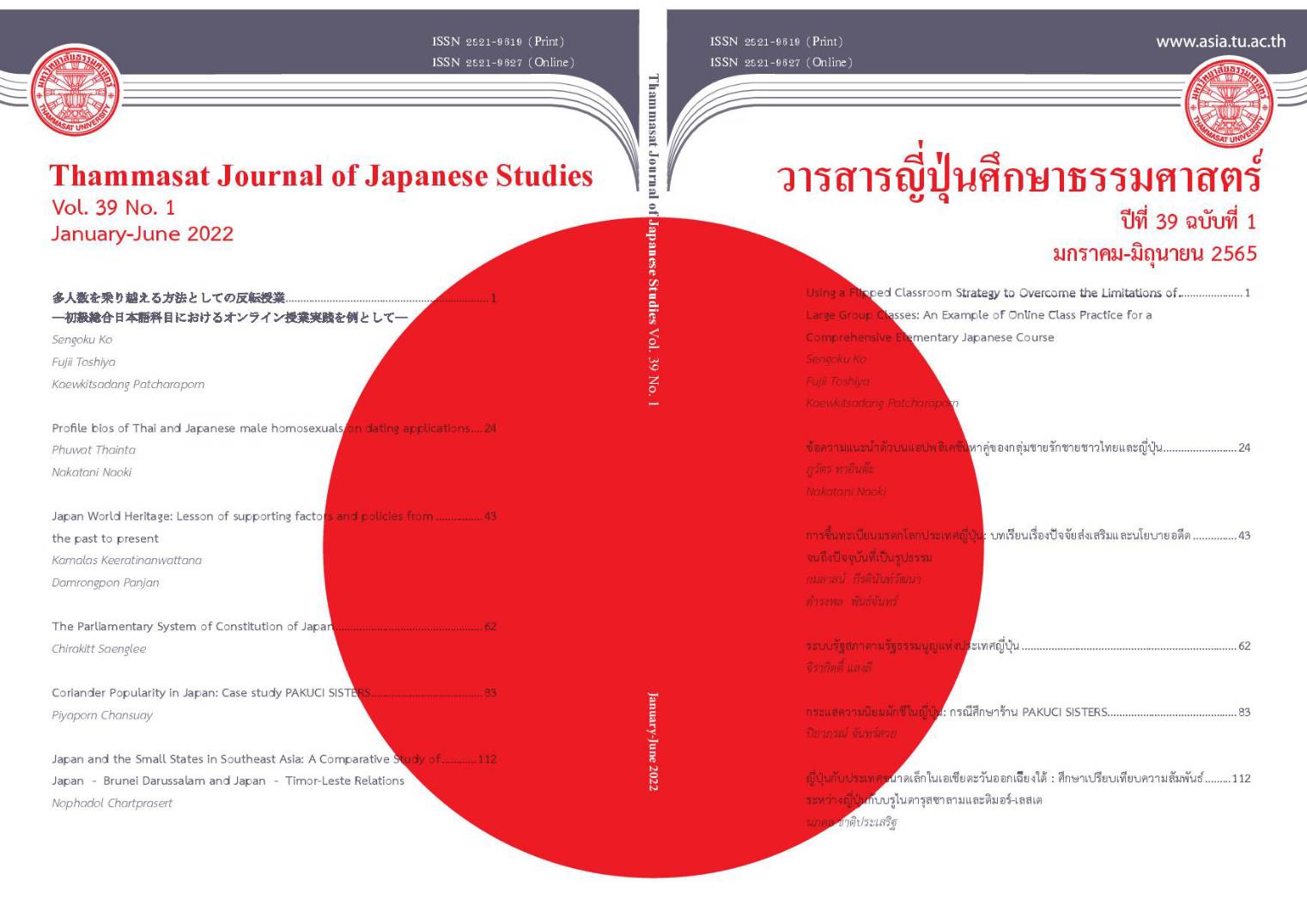Profile bios of Thai and Japanese male homosexuals on dating applications
Keywords:
dating applications, self-introduction, Thai male homosexuals, Japanese male homosexualsAbstract
This research aims to analyse and compare the profile bios of Thai and Japanese male homosexuals on dating applications. 100 statements from profiles were collected for analysis. It is found that there are similarities and differences between how Thai and Japanese male homosexuals introduced themselves on dating applications. Regarding similarities, many of the collected statements involved self description. It can be said that despite linguistic and cultural differences, the connection between the two groups is the emphasis on one’s qualities. Self description of one’s qualities was a significant
factor in other parties deciding whether or not to initiate a relationship with a given individual.
In terms of differences, Japanese male homosexuals used statements expressing one’s desire more than their Thai counterparts. This highlights the socio-cultural difference between Thai and Japanese people in that, for the latter, process and time are required to build a relationship. These requirements can be explained in relation to the insider-outsider distinction. In Japanese culture, for an outsider to become an insider, it is essential to be acquaintances and have mutual trust. In addition, the collected data
reveals that the two groups hold different views of relationships. There is a greater tendency for Japanese individuals to set high expectations and seek a serious relationship. Based on language use in profile bios of Thai and Japanese male homosexuals on dating applications, it can be concluded that although users of social networking platforms targeted for male homosexuals may have similar purposes, socio-cultural differences influence their views towards relationship building.
Downloads
References
นฤพนธ์ ด้วงวิเศษ. (2545). ตำนานสวนสาธารณะกับเรื่องเล่าชาวเกย์กรุงเทพในพรมแดนเทคโนโลยีสื่อสาร (The City Park Myth: Narratives of Bangkok Gay Male in Cyberspace). รัฐศาสตร์สาร, 23(1), 77-116.
นฤพนธ์ ด้วงวิเศษ. (2552). ไบ แมน รุก ความเป็นชายกับปัญหาตัวตนเกย์ไทยในไซเบอร์สเปซ. ไทยคดีศึกษา, 2(1),188-226.
นฤพนธ์ ด้วงวิเศษ. (2561). การแผ่ขยายตัวของการเสพและสร้างความเป็นชายในชุมชนเกย์ไทยสมัยใหม่จากทศวรรษ 2500-2550. วารสารมานุษยวิทยา, 2(1), 130-182.
เนติ สุนทราวราวิทย์. (2553). การสร้างความหมายและตัวตน “เกย์”ในพื้นที่แห่งความเป็นจริงและพื้นที่ไซเบอร์. วิทยานิพนธ์ศิลปศาสตรมหาบัณฑิต. มหาวิทยาลัยสงขลานครินทร์.
ปีเตอร์ เอ แจ็คสัน, และนฤพนธ์ ด้วงวิเศษ. (2552). เปิดประตูสีรุ้ง หนังสือและเว็บไซต์ของเกย์-กะเทยในสังคมไทย. มูลนิธิสร้างความเข้าใจเรื่องสุขภาพของผู้หญิง.
ภูวัตร ทาอินต๊ะ. (2557, 20-21 พฤศจิกายน). การวิเคราะห์เนื้อหาข้อความที่ใช้แสดงสถานะบนเครื่อข่ายสังคมออนไลน์ของกลุ่มชายรักชายชาวญี่ปุ่น. เอกสารนำเสนอ. การประชุมวิชาการนานาชาติด้านมนุษยศาสตร์และสังคมศาสตร์. ขอนแก่น, ประเทศไทย.
Baudinette, T. (2017). Constructing identities on Japanese gay dating site: Hunkiness cuteness and the desire for heteronormative masculinity. Journal of Language and Sexuality, 6(2), 232-261.
Brown, P., & Levinson, S. C. (1987). Politeness: Some Universals in Language Usage. Cambridge University Press.
Goffman, E. (1959). The Presentation of Self in Every Life. Doubleday Anchor.
Kinjo, K. (2010). Are there any Tops who can fuck me?: The quantitative analysis of posts on a Japanese gay dating Bulletin Board System in Okinawa Prefecture. Journal of Queer Studies Japan, 3, 39-61. (in Japanese)
Downloads
Published
Issue
Section
License
Copyright (c) 2022 Thammasat Journal of Japanese Studies

This work is licensed under a Creative Commons Attribution-NonCommercial-NoDerivatives 4.0 International License.




